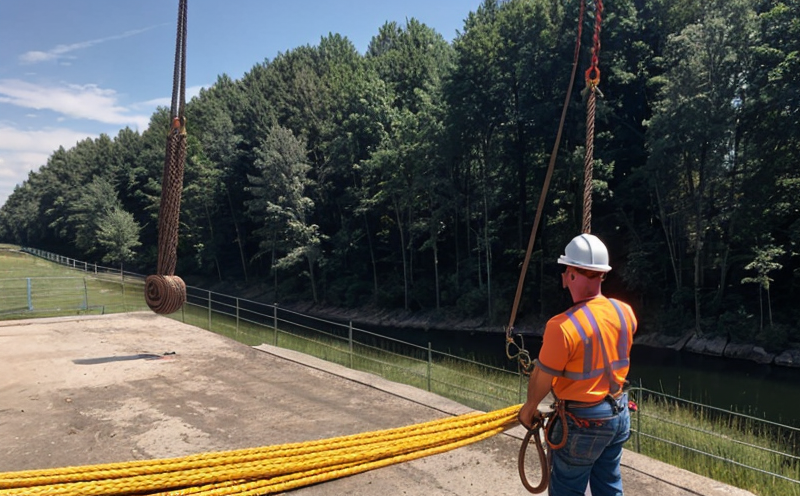Wire rope sling inspection
The inspection of wire rope slings is a critical component in ensuring the safety and reliability of lifting equipment used across various industries. Wire ropes are subjected to high loads during use, making them susceptible to wear, corrosion, and other forms of damage that can compromise their integrity. The purpose of this inspection service is to identify any potential hazards before they lead to catastrophic failure.
Wire rope slings come in different types, including single-strand, braided, and wire-rope-core slings. Each type has its unique properties and applications. For instance, a single-strand sling is typically used for light-duty lifting, while a wire-rope-core sling is preferred for heavy-duty applications due to its strength and flexibility.
The inspection process begins with visual examination, where the inspector checks for visible signs of damage such as fraying, corrosion, or cuts. This step is crucial in identifying any issues that may not be immediately apparent during use. After the visual inspection, the wire rope sling undergoes a more detailed examination using specialized instruments. These tools help detect internal defects such as core shifts and broken wires.
The inspection process also involves testing the slings' strength and flexibility. This is done by subjecting them to a specified load, typically 1.25 times their rated working load (RLL). The sling must not exhibit any signs of deformation or failure under this test. Additionally, the flexibility of the wire rope sling is tested by bending it through its full range of motion.
The acceptance criteria for wire rope slings are based on international standards such as ISO 4302 and ASTM F1786. These standards provide detailed guidelines on how to perform these inspections and what constitutes acceptable levels of wear, corrosion, and other forms of damage. Compliance with these standards ensures that the inspection process is both consistent and reliable.
It is important to note that regular inspections are necessary for maintaining the safety and longevity of wire rope slings. Failing to do so can lead to accidents, injuries, and costly downtime due to equipment failures. By adhering to a proactive maintenance program, businesses can minimize these risks and ensure their lifting equipment operates safely and efficiently.
Wire rope sling inspection is particularly critical in sectors such as construction, manufacturing, and offshore oil & gas exploration where the use of heavy-duty lifting equipment is common. In these industries, even minor defects in wire rope slings can have severe consequences. Regular inspections help prevent accidents and ensure compliance with regulatory requirements.
For quality managers, compliance officers, R&D engineers, and procurement professionals responsible for ensuring safety and reliability in their operations, wire rope sling inspection is an essential service that should not be overlooked. By investing in this service, they can contribute to a safer working environment and prevent costly accidents.
Industry Applications
- Construction sites where heavy equipment is used for lifting materials and machinery.
- Mining operations that require the use of slings to transport raw materials from deep within mines.
- Offshore oil platforms where wire rope slings are used in drilling and maintenance activities.
- Petrochemical plants requiring frequent lifting of large components during maintenance and installation processes.
The inspection service can be tailored to meet the specific requirements of these industries, ensuring that each application receives the appropriate level of scrutiny. For instance, construction sites may require more frequent inspections due to the constant movement and use of heavy equipment, while offshore oil platforms may need specialized tools and expertise to perform inspections in harsh environmental conditions.
By providing tailored inspection services for different industry applications, we ensure that businesses can maintain their lifting equipment at optimal levels of safety and reliability. This not only helps prevent accidents but also improves overall operational efficiency by minimizing downtime due to equipment failures.
Why Choose This Test
- Comprehensive Assessment: Our wire rope sling inspection service provides a thorough examination of the slings, ensuring that no defects go unnoticed. This comprehensive approach ensures maximum safety and reliability.
- Expertise in Specialized Equipment: We utilize state-of-the-art tools and techniques to inspect even the most challenging slings. Our expertise allows us to identify subtle flaws that may not be apparent to other inspectors.
- Regulatory Compliance: By adhering to international standards such as ISO 4302 and ASTM F1786, we ensure that our inspections meet all relevant regulatory requirements. This helps businesses avoid potential legal issues and fines.
- Proactive Approach: Regular inspections can prevent accidents before they happen. Our proactive approach ensures that any potential hazards are identified and addressed promptly, reducing the risk of accidents and injuries.
- Certified Reports: We provide detailed reports documenting all aspects of the inspection process. These reports serve as a valuable resource for compliance officers and quality managers to review and act upon.
The wire rope sling inspection service is an essential part of any safety program in industries reliant on heavy lifting equipment. By choosing this test, businesses can ensure that their lifting equipment operates safely and efficiently, minimizing the risk of accidents and downtime.
International Acceptance and Recognition
The wire rope sling inspection service is widely recognized and accepted across various international standards. Compliance with these standards ensures that inspections are consistent and reliable worldwide. Some key standards include ISO 4302, which provides guidelines for the mechanical testing of wire ropes, and ASTM F1786, which specifies requirements for the inspection of wire rope slings.
Many countries around the world have adopted these international standards as their own national regulations. This uniformity in standards helps ensure that businesses operating internationally can maintain consistent practices across different regions. For example, a company based in Europe may use ISO 4302 to conduct inspections, but if it operates in North America, it would adhere to ASTM F1786.
By adhering to these international standards, we not only ensure the highest level of safety and reliability for our clients' lifting equipment but also facilitate seamless operations across borders. This is particularly important for businesses with global operations or those exporting products internationally.





